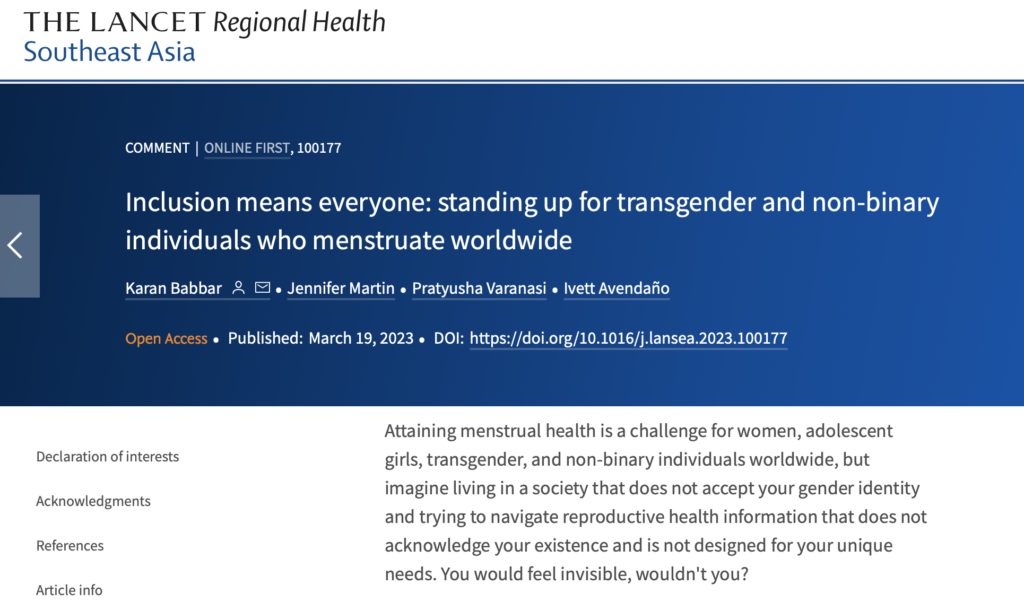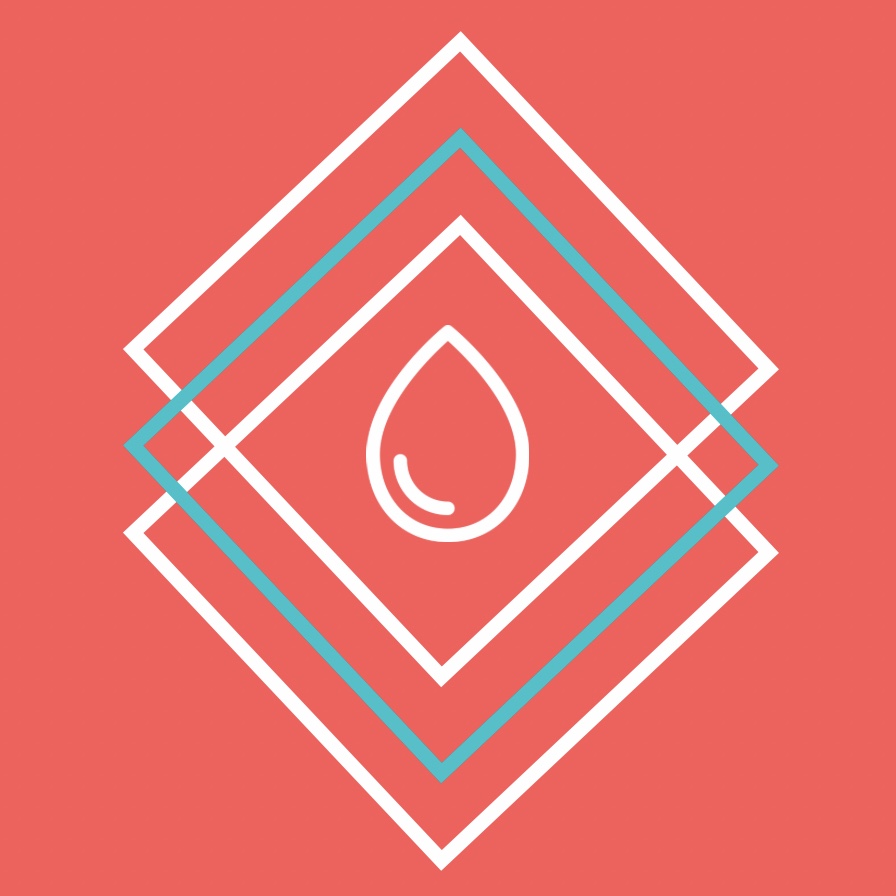
Attaining menstrual health is a challenge for women, adolescent girls, transgender, and non-binary individuals worldwide, but imagine living in a society that does not accept your gender identity and trying to navigate reproductive health information that does not acknowledge your existence and is not designed for your unique needs. You would feel invisible, wouldn’t you?
There is a need for inclusive menstrual health programming that supports gender-diverse people, such as transgender men and non-binary individuals.1 Currently, the menstrual health discourse in most countries excludes gender-diverse people,2 and this is particularly true in low and middle-income countries (LMICs).3 In LMICs, menstruation is still taboo – socially and culturally crafted with patriarchal notions and surrounded by myths.4 The academic literature is similar – with much of it being viewed through the lens of a cis-woman, thus publicising only the adolescent girls’ and cis-woman’s perception of menstruation.1
Women and adolescent girls experience unique challenges that result in gender inequality and can manifest in gender-based violence, lack of access to sexual or reproductive health (SRH) education and services, or inability to access education. Without excluding, erasing, or undermining the SRH of women or adolescent girls, we believe that the following areas could be improved to support the needs of gender-diverse people in the menstrual health narrative:
Inclusivity starts with language.5,6 A common term used in academia to account for adolescent girls, women, transgender men, non-binary and agender people, and other gender minorities who menstruate is ‘menstruators.’ Therefore, we suggest using the term women, adolescent girls and people who menstruate. This term was first coined to support the inclusion of all women, adolescent girls, and people who menstruate, but instead reduced them to their bodily functions and body parts.7 This sweeping language also extends to period products, frequently categorised as “women’s hygiene products”, indicating that the products are only for women and that menstrual health is only a “hygiene” issue. Multiple transgender and non-binary individuals have suggested this induces higher gender dysphoria during menstruation.2 Products should be labelled “period products,” and terms that indicate they are unclean should be avoided.
Additional stigma and discrimination associated with gender minorities have impeded their access to even the benefits cis-adolescent girls and women can avail. For instance, free period products are available to cis-gender individuals who menstruate in some settings, but no provisions have been made for trans and non-binary individuals who menstruate.
Changing gender identity can lead to challenges in obtaining health as the healthcare system does not recognise the specific needs of gender-diverse individuals. Healthcare workers should receive training on the ethics and best practices for treating gender-diverse patients. Previous survey studies conducted on certified obstetricians and gynaecologists have shown that only a few received trainings on sensitised care for transgender patients.8 Many trans and non-binary individuals who menstruate may avoid visiting a gynaecologist to discuss their menstrual experiences because they fear being misgendered, invalidated, humiliated, and disrespected.9
Another issue is that many trans and non-binary individuals who menstruate need to use washrooms labelled with the same gender binaries for “men” and “women”. A recent systematic review has shown that trans and non-binary individuals who menstruate do not find the men’s washrooms safe to change their period products,10 as waste bins are not available in the cubicles of men’s washrooms. Gender-neutral washrooms are one solution, but may be considered unsafe or inappropriate in some settings. Therefore, another is to provide bins in cubicles of men’s washrooms.
Due to prevailing taboos and myths, the colonial view of gender as binary, and patriarchal notions, many countries do not collect data on gender-diverse individuals. The lack of data creates difficulties in prioritising these invisible voices. In the future, surveys such as the demographic and health survey (DHS) and others should include trans and non-binary people in their respondent pools.
To conclude, acknowledging the intersectionality of menstrual needs and rights is a step forward towards questioning the colonial epistemology and politics of mainstream discourse around menstruation. There exists a wide variety of people who experience menstruation, with diverse political qualities, and gender identities, who can be in any phase of the life cycle, including adolescence, adulthood, and peri-menopausal and menopausal. Thus, it is essential to co-develop menstrual health programming, research, and policies based on diverse needs. In recent years, we have witnessed some transgender men and non-binary individuals being more vocal about their menstrual experiences (particularly from high-income countries); this is only a window into a more profound issue.3
The right to menstrual health of individuals from the LGBTQIA+ community must be protected, particularly in contexts where their human rights and visibility are under threat. To provide menstrual health, we must advocate for products, spaces, education, and services suitable for women, adolescent girls, transgender men, and non-binary individuals across age groups and socio-political contexts so that they can manage their periods with safety and dignity.
Just because people may not be visible does not mean they are not present in the community. We believe that you cannot pick and choose when you want to be inclusive. Inclusion means everyone.
Declaration of interests
We declare no competing interests.
Acknowledgments
Funding: The work was carried out on voluntary basis.
References
- 1.
- Weiselberg E.
- 2.
- Lowik A.J.
- 3.
- Barrington D.J.
- Robinson H.J.
- Wilson E.
- et al.
- 4.
- Sommer M.
- Sahin M.
- 5.
- Kamau R.
- Martin J.S.
- Calderón-Villarreal A.
- et al.
- 6.
- Martin J.
- Babbar K.
- Maschette U.
- 7.
- Babbar K.
- Martin J.
- Ruiz J.
- et al.
- 8.
- Stroumsa D.
- Shires D.A.
- Richardson C.R.
- et al.
- 9.
- James S.E.
- Herman J.L.
- Rankin S.
- et al.
- 10.
- Defreyne J.
- Motmans J.
- T’sjoen G.
Article info
Publication history
Published: March 19, 2023
Accepted: February 27, 2023
Received in revised form: February 17, 2023
Received: October 10, 2022
Identification
DOI: https://doi.org/10.1016/j.lansea.2023.100177
Copyright
© 2023 The Author(s). Published by Elsevier Ltd.
User license
Creative Commons Attribution – NonCommercial – NoDerivs (CC BY-NC-ND 4.0) |

